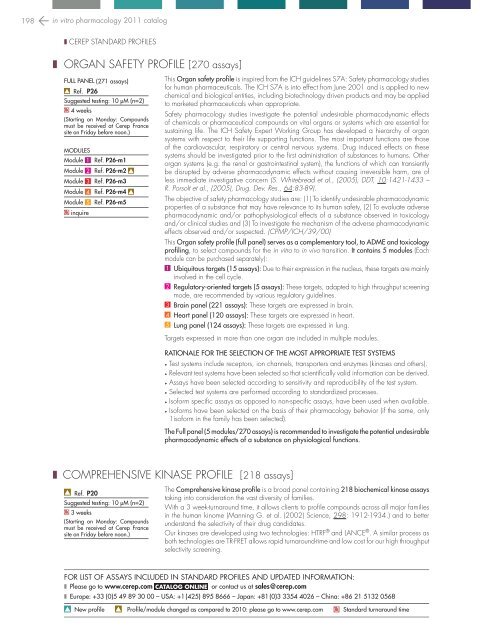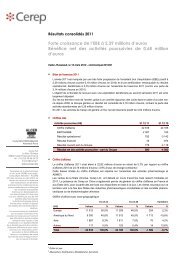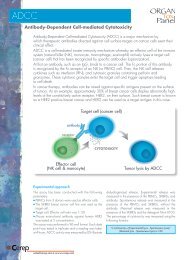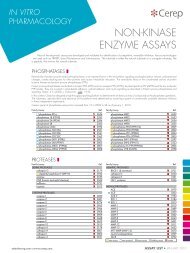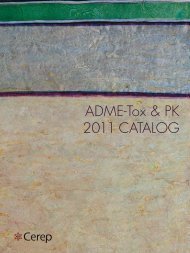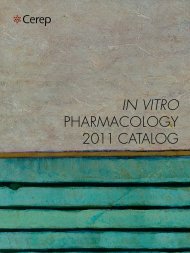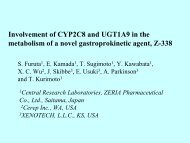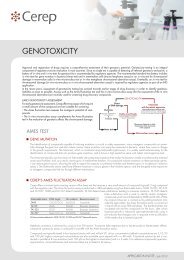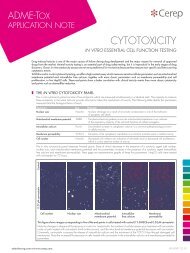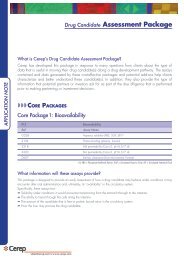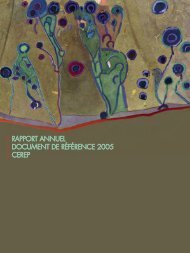in vitro PHARMACOLOGY 2011 CATALOG - Cerep
in vitro PHARMACOLOGY 2011 CATALOG - Cerep
in vitro PHARMACOLOGY 2011 CATALOG - Cerep
Create successful ePaper yourself
Turn your PDF publications into a flip-book with our unique Google optimized e-Paper software.
198 <strong>in</strong> <strong>vitro</strong> pharmacology <strong>2011</strong> catalog<br />
❚ <strong>Cerep</strong> standard profiles<br />
❚ Organ safety profile [270 assays]<br />
full panel (271 assays)<br />
Ref. P26<br />
Suggested test<strong>in</strong>g: 10 µM (n=2)<br />
Q 4 weeks<br />
(Start<strong>in</strong>g on Monday: Compounds<br />
must be received at <strong>Cerep</strong> France<br />
site on Friday before noon.)<br />
MODULES<br />
Module 1 Ref. P26-m1<br />
Module 2 Ref. P26-m2 <br />
Module 3<br />
Module 4<br />
Module 5<br />
Q <strong>in</strong>quire<br />
Ref. P26-m3<br />
Ref. P26-m4 <br />
Ref. P26-m5<br />
This Organ safety profile is <strong>in</strong>spired from the ICH guidel<strong>in</strong>es S7A: Safety pharmacology studies<br />
for human pharmaceuticals. The ICH S7A is <strong>in</strong>to effect from June 2001 and is applied to new<br />
chemical and biological entities, <strong>in</strong>clud<strong>in</strong>g biotechnology driven products and may be applied<br />
to marketed pharmaceuticals when appropriate.<br />
Safety pharmacology studies <strong>in</strong>vestigate the potential undesirable pharmacodynamic effects<br />
of chemicals or pharmaceutical compounds on vital organs or systems which are essential for<br />
susta<strong>in</strong><strong>in</strong>g life. The ICH Safety Expert Work<strong>in</strong>g Group has developed a hierarchy of organ<br />
systems with respect to their life support<strong>in</strong>g functions. The most important functions are those<br />
of the cardiovascular, respiratory or central nervous systems. Drug <strong>in</strong>duced effects on these<br />
systems should be <strong>in</strong>vestigated prior to the first adm<strong>in</strong>istration of substances to humans. Other<br />
organ systems (e.g. the renal or gastro<strong>in</strong>test<strong>in</strong>al system), the functions of which can transiently<br />
be disrupted by adverse pharmacodynamic effects without caus<strong>in</strong>g irreversible harm, are of<br />
less immediate <strong>in</strong>vestigative concern (S. Whitebread et al., (2005), DDT, 10:1421-1433 –<br />
R. Porsolt et al., (2005), Drug. Dev. Res., 64:83-89).<br />
The objective of safety pharmacology studies are: (1) To identify undesirable pharmacodynamic<br />
properties of a substance that may have relevance to its human safety, (2) To evaluate adverse<br />
pharmacodynamic and/or pathophysiological effects of a substance observed <strong>in</strong> toxicology<br />
and/or cl<strong>in</strong>ical studies and (3) To <strong>in</strong>vestigate the mechanism of the adverse pharmacodynamic<br />
effects observed and/or suspected. (CPMP/ICH/39/00)<br />
This Organ safety profile (full panel) serves as a complementary tool, to ADME and toxicology<br />
profil<strong>in</strong>g, to select compounds for the <strong>in</strong> <strong>vitro</strong> to <strong>in</strong> vivo transition. It conta<strong>in</strong>s 5 modules (Each<br />
module can be purchased separately):<br />
1 Ubiquitous targets (15 assays): Due to their expression <strong>in</strong> the nucleus, these targets are ma<strong>in</strong>ly<br />
<strong>in</strong>volved <strong>in</strong> the cell cycle.<br />
2 Regulatory-oriented targets (5 assays): These targets, adapted to high throughput screen<strong>in</strong>g<br />
mode, are recommended by various regulatory guidel<strong>in</strong>es.<br />
3 Bra<strong>in</strong> panel (221 assays): These targets are expressed <strong>in</strong> bra<strong>in</strong>.<br />
4 Heart panel (120 assays): These targets are expressed <strong>in</strong> heart.<br />
5 Lung panel (124 assays): These targets are expressed <strong>in</strong> lung.<br />
Targets expressed <strong>in</strong> more than one organ are <strong>in</strong>cluded <strong>in</strong> multiple modules.<br />
Rationale for the selection of the most appropriate test systems<br />
Test systems <strong>in</strong>clude receptors, ion channels, transporters and enzymes (k<strong>in</strong>ases and others).<br />
Relevant test systems have been selected so that scientifically valid <strong>in</strong>formation can be derived.<br />
Assays have been selected accord<strong>in</strong>g to sensitivity and reproducibility of the test system.<br />
Selected test systems are performed accord<strong>in</strong>g to standardized processes.<br />
Isoform specific assays as opposed to non-specific assays, have been used when available.<br />
Isoforms have been selected on the basis of their pharmacology behavior (if the same, only<br />
1isoform <strong>in</strong> the family has been selected).<br />
The Full panel (5 modules/270 assays) is recommended to <strong>in</strong>vestigate the potential undesirable<br />
pharmacodynamic effects of a substance on physiological functions.<br />
❚ Comprehensive KINASE profile [218 assays]<br />
Ref. P20<br />
Suggested test<strong>in</strong>g: 10 µM (n=2)<br />
Q 3 weeks<br />
(Start<strong>in</strong>g on Monday: Compounds<br />
must be received at <strong>Cerep</strong> France<br />
site on Friday before noon.)<br />
The Comprehensive k<strong>in</strong>ase profile is a broad panel conta<strong>in</strong><strong>in</strong>g 218 biochemical k<strong>in</strong>ase assays<br />
tak<strong>in</strong>g <strong>in</strong>to consideration the vast diversity of families.<br />
With a 3 week-turnaround time, it allows clients to profile compounds across all major families<br />
<strong>in</strong> the human k<strong>in</strong>ome (Mann<strong>in</strong>g G. et al. (2002) Science, 298: 1912-1934.) and to better<br />
understand the selectivity of their drug candidates.<br />
Our k<strong>in</strong>ases are developed us<strong>in</strong>g two technologies: HTRF ® and LANCE ® . A similar process as<br />
both technologies are TR-FRET allows rapid turnaround-time and low cost for our high throughput<br />
selectivity screen<strong>in</strong>g.<br />
For list of assays <strong>in</strong>cluded <strong>in</strong> standard profiles and updated <strong>in</strong>formation:<br />
❚ Please go to www.cerep.com catalog onl<strong>in</strong>e or contact us at sales@cerep.com<br />
❚ Europe: +33 (0)5 49 89 30 00 – USA: +1 (425) 895 8666 – Japan: +81 (0)3 3354 4026 – Ch<strong>in</strong>a: +86 21 5132 0568<br />
New profile Profile/module changed as compared to 2010: please go to www.cerep.com Q Standard turnaround time


